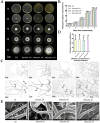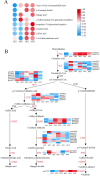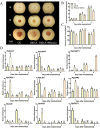Melatonin enhances resistance to Botryosphaeria dothidea in pear by promoting jasmonic acid and phlorizin biosynthesis
- PMID: 38811892
- PMCID: PMC11134937
- DOI: 10.1186/s12870-024-05187-1
Melatonin enhances resistance to Botryosphaeria dothidea in pear by promoting jasmonic acid and phlorizin biosynthesis
Abstract
Ring rot, caused by Botryosphaeria dothidea, is an important fungal disease of pear fruit during postharvest storage. Melatonin, as a plant growth regulator, plays an important role in enhancing the stress resistance of pear fruits. It enhances the resistance of pear fruits to ring rot by enhancing their antioxidant capacity. However, the underlying mechanism remains unclear. In this study, we examined the effect of melatonin on the growth of B. dothidea. Results showed that melatonin did not limit the growth of B. dothidea during in vitro culture. However, metabolomics and transcriptomics analyses of 'Whangkeumbae' pear (Pyrus pyrifolia) revealed that melatonin increased the activity of antioxidant enzymes, including peroxidase (POD), superoxide dismutase (SOD), and polyphenol oxidase (PPO), in the fruit and activated the phenylpropanoid metabolic pathway to improve fruit resistance. Furthermore, melatonin treatment significantly increased the contents of jasmonic acid and phlorizin in pear fruit, both of which could improve disease resistance. Jasmonic acid regulates melatonin synthesis and can also promote phlorizin synthesis, ultimately improving the resistance of pear fruit to ring rot. In summary, the interaction between melatonin and jasmonic acid and phlorizin enhances the antioxidant defense response and phenylpropanoid metabolism pathway of pear fruit, thereby enhancing the resistance of pear fruit to ring rot disease. Our results provide new insights into the application of melatonin in the resistance to pear fruit ring rot.
Keywords: Botryosphaeria dothidea; Disease resistance; Jasmonic acid; Melatonin; Pear; Phlorizin.
© 2024. The Author(s).
Conflict of interest statement
The authors declare that they have no known competing financial interests or personal relationships that could have appeared to influence the work reported in this paper.
Figures








Similar articles
-
Exogenous Melatonin Improves Pear Resistance to Botryosphaeria dothidea by Increasing Autophagic Activity and Sugar/Organic Acid Levels.Phytopathology. 2022 Jun;112(6):1335-1344. doi: 10.1094/PHYTO-11-21-0489-R. Epub 2022 Apr 27. Phytopathology. 2022. PMID: 34989595
-
Revealing the early response of pear (Pyrus bretschneideri Rehd) leaves during Botryosphaeria dothideainfection by transcriptome analysis.Plant Sci. 2022 Feb;315:111146. doi: 10.1016/j.plantsci.2021.111146. Epub 2021 Dec 6. Plant Sci. 2022. PMID: 35067309
-
Transcription factors Pbr3RAV2 and PbrTTG1 regulate pear resistance to Botryosphaeria dothidea via the autophagy pathway.Plant Physiol. 2024 Jul 31;195(4):3024-3038. doi: 10.1093/plphys/kiae252. Plant Physiol. 2024. PMID: 38696652
-
Botryosphaeria dothidea: a latent pathogen of global importance to woody plant health.Mol Plant Pathol. 2017 May;18(4):477-488. doi: 10.1111/mpp.12495. Epub 2016 Dec 13. Mol Plant Pathol. 2017. PMID: 27682468 Free PMC article. Review.
-
Methyl Jasmonate: An Alternative for Improving the Quality and Health Properties of Fresh Fruits.Molecules. 2016 May 31;21(6):567. doi: 10.3390/molecules21060567. Molecules. 2016. PMID: 27258240 Free PMC article. Review.
Cited by
-
Comparative Transcriptome and Volatile Metabolome Analysis of Gossypium hirsutum Resistance to Verticillium Wilt.Genes (Basel). 2025 Jul 25;16(8):877. doi: 10.3390/genes16080877. Genes (Basel). 2025. PMID: 40869925 Free PMC article.
-
Melatonin in plant pathogen defense: a review of its role in horticultural crops.Hortic Res. 2025 Jun 11;12(9):uhaf150. doi: 10.1093/hr/uhaf150. eCollection 2025 Sep. Hortic Res. 2025. PMID: 40861042 Free PMC article.
References
-
- Hu WC, Luo H, Yang YK, Wang Q, Hong N, Wang GP, Wang AM, Wang LP. Comprehensive analysis of full genome sequence and Bd-milRNA/target mRNAs to discover the mechanism of hypovirulence in Botryosphaeria dothidea strains on pear infection with BdCV1 and BdPV1. Ima Fungus. 2019;10:3. doi: 10.1186/s43008-019-0008-4. - DOI - PMC - PubMed
MeSH terms
Substances
Supplementary concepts
Grants and funding
LinkOut - more resources
Full Text Sources

